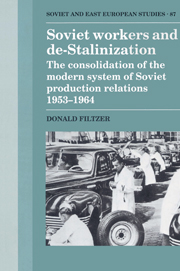 Soviet Workers and De-Stalinization
Soviet Workers and De-Stalinization Book contents
- Frontmatter
- Contents
- List of tables
- Preface and acknowledgements
- List of terms and abbreviations
- Introduction: the contradictions of-Stalinization
- Part I Labour policy under Khrushchev: issues and results
- 1 The worker and the work environment
- 2 The reform of labour legislation and the re-emergence of the labour market
- 3 The labour shortage
- 4 The wage reform
- Part II De-Stalinization and the Soviet labour process
- Conclusion
- Notes
- Bibliography
- Index of industrial, mining, and construction enterprises
- General index
- Soviet and East European Studies
2 - The reform of labour legislation and the re-emergence of the labour market
Published online by Cambridge University Press: 29 January 2010
- Frontmatter
- Contents
- List of tables
- Preface and acknowledgements
- List of terms and abbreviations
- Introduction: the contradictions of-Stalinization
- Part I Labour policy under Khrushchev: issues and results
- 1 The worker and the work environment
- 2 The reform of labour legislation and the re-emergence of the labour market
- 3 The labour shortage
- 4 The wage reform
- Part II De-Stalinization and the Soviet labour process
- Conclusion
- Notes
- Bibliography
- Index of industrial, mining, and construction enterprises
- General index
- Soviet and East European Studies
Summary
De-Stalinization, if it was to have its desired impact, had to extend to the workplace. Repression, even in the 1930s, had simply failed to prove itself a viable stimulus to work. In 1956, therefore, the regime set out on a different path to try to create a popular feeling of identification with the system and its leadership. The 1940 criminalization of job-changing and absenteeism was repealed, so that workers could switch jobs without fear of legal reprisals. There was also an extensive reform of the trade unions, designed to give them the appearance, if not the reality, of greater responsibility to their members. As part of this reform, new labour regulations made it far more difficult for managers to fire workers except for serious discipline violations. A coercive element was to be retained, but this was to be enforced in the main not through labour law, but through the incentive system, as implemented in the wage reform of 1956–62, which is discussed at length in chapter 4.
The reform of labour law meant significant changes in the state of the labour market. Workers were once more free to move about at will and had less to fear from the threat of dismissal. These changes, which had been essential from the point of view of the political liberalization of Soviet society, at the same time pushed the balance of power on the shop floor a little more in workers' favour, and in this sense helped to undermine the regime's economic strategy.
- Type
- Chapter
- Information
- Soviet Workers and De-StalinizationThe Consolidation of the Modern System of Soviet Production Relations 1953–1964, pp. 35 - 58Publisher: Cambridge University PressPrint publication year: 1992


